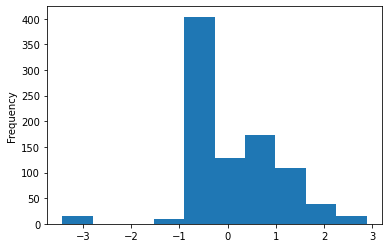Data Cleaning¶
Nu we de data hebben leren kennen. Kunnen we data beginnen op kuisen. We willen de data waar we op verder werken zo clean mogelijk hebben. We moeten een strategie bepalen wat te doen met missing values en wat doen we met dubbele records.
Missing values¶
Een eerste stap is steed om niet relevante kolomen te verwijderen. Na elke cleaning stap kunnen we via EDA terug kijken naar de data en proberen om onze dat niog beter te begrijpen.
#Import Libraries
import numpy as np
import pandas as pd
import matplotlib.pylab as plt
import seaborn as sns
from sklearn import datasets
data =datasets.load_boston()
df = pd.DataFrame(data.data, columns=data.feature_names)
df.head()
| CRIM | ZN | INDUS | CHAS | NOX | RM | AGE | DIS | RAD | TAX | PTRATIO | B | LSTAT | |
|---|---|---|---|---|---|---|---|---|---|---|---|---|---|
| 0 | 0.00632 | 18.0 | 2.31 | 0.0 | 0.538 | 6.575 | 65.2 | 4.0900 | 1.0 | 296.0 | 15.3 | 396.90 | 4.98 |
| 1 | 0.02731 | 0.0 | 7.07 | 0.0 | 0.469 | 6.421 | 78.9 | 4.9671 | 2.0 | 242.0 | 17.8 | 396.90 | 9.14 |
| 2 | 0.02729 | 0.0 | 7.07 | 0.0 | 0.469 | 7.185 | 61.1 | 4.9671 | 2.0 | 242.0 | 17.8 | 392.83 | 4.03 |
| 3 | 0.03237 | 0.0 | 2.18 | 0.0 | 0.458 | 6.998 | 45.8 | 6.0622 | 3.0 | 222.0 | 18.7 | 394.63 | 2.94 |
| 4 | 0.06905 | 0.0 | 2.18 | 0.0 | 0.458 | 7.147 | 54.2 | 6.0622 | 3.0 | 222.0 | 18.7 | 396.90 | 5.33 |
df = df.copy().drop(['ZN'], axis=1)
Eventueel kolommen met teveel missing values verwijderen
NA_val = df.isna().sum()
NA_val
CRIM 0
INDUS 0
CHAS 0
NOX 0
RM 0
AGE 0
DIS 0
RAD 0
TAX 0
PTRATIO 0
B 0
LSTAT 0
dtype: int64
def na_filter(na, threshold = .4): #only select variables that passees the threshold
col_pass = []
for i in na.keys():
if na[i]/df.shape[0]<threshold:
col_pass.append(i)
return col_pass
df = df[na_filter(NA_val)]
df.columns
Index(['CRIM', 'INDUS', 'CHAS', 'NOX', 'RM', 'AGE', 'DIS', 'RAD', 'TAX',
'PTRATIO', 'B', 'LSTAT'],
dtype='object')
Aangezien we geen missing values hebben blijven alle kolommen hier behouden.
Missing data kunnen we ook oplossen door een lege kolom in te vullen met een waarde. Typisch wordt er dan gekeken naar de verdeling van de andere data en nemen we het gemiddelde van de andere data. Hou wel rekening met het feit dat je zelf dan wel eigenlijk verschillende veronderstellingen in de data aan het brengen bent. Deze missing data strategy kan best met domein expertent afgetoetst worden.
Outliers¶
We gaan kijken via EDA of er geen vreemde waardes in onze dataset zitten en we gaan deze eventueel verwijderen.
Stel onze dataset mag enkel volwassenen bevatten dan kunnen we de records met een leeftijd minder dan 18j gaan verwijderen.
df = df[df['AGE'].between(18, 75)]
df.describe().apply(lambda s: s.apply(lambda x: format(x, 'f')))
| CRIM | INDUS | CHAS | NOX | RM | AGE | DIS | RAD | TAX | PTRATIO | B | LSTAT | |
|---|---|---|---|---|---|---|---|---|---|---|---|---|
| count | 217.000000 | 217.000000 | 217.000000 | 217.000000 | 217.000000 | 217.000000 | 217.000000 | 217.000000 | 217.000000 | 217.000000 | 217.000000 | 217.000000 |
| mean | 0.601116 | 6.688848 | 0.050691 | 0.475648 | 6.402037 | 47.441935 | 5.109055 | 5.691244 | 320.110599 | 17.941014 | 384.657834 | 8.848986 |
| std | 1.975536 | 4.643262 | 0.219874 | 0.058566 | 0.604022 | 16.571513 | 1.989007 | 5.267965 | 110.757479 | 1.908030 | 42.826531 | 3.748327 |
| min | 0.006320 | 0.460000 | 0.000000 | 0.385000 | 4.973000 | 18.400000 | 1.986500 | 1.000000 | 187.000000 | 12.600000 | 3.650000 | 2.470000 |
| 25% | 0.044170 | 3.410000 | 0.000000 | 0.433000 | 5.927000 | 33.100000 | 3.554900 | 4.000000 | 254.000000 | 16.600000 | 388.650000 | 6.050000 |
| 50% | 0.081990 | 5.320000 | 0.000000 | 0.458000 | 6.312000 | 47.200000 | 4.779400 | 4.000000 | 289.000000 | 18.300000 | 393.370000 | 8.440000 |
| 75% | 0.188360 | 8.140000 | 0.000000 | 0.515000 | 6.728000 | 61.800000 | 6.458400 | 5.000000 | 345.000000 | 19.200000 | 396.900000 | 11.410000 |
| max | 15.575700 | 25.650000 | 1.000000 | 0.655000 | 8.337000 | 75.000000 | 12.126500 | 24.000000 | 666.000000 | 22.000000 | 396.900000 | 21.140000 |
Rijen met null waardes kunnen we best ook verwijderen
df = df.dropna(axis=0)
df.shape
(217, 12)
Outliers kunnen we ook laten detecteren door modellen zelf. We gaan hier niet verder in detail maar dit zijn voorbeelden van ML modellen om outliers te gaan detecteren. Bij het trainen van deze modellen moet je de fractie van outliers meegeven. Het is dus belangrijk om via EDA een gevoel te krijgen betreffende de outliers.
Isolation Forest
k-Nearest Neighbors Detector
In een ML pipeline kunnen deze outliers dan weer speciale aandacht krijgen. Typisch worden deze ML modellen gebruikt als we de outliers niet per single feature kunnen gaan wegfilteren. Bij model training gaan we hier iets verder op in.
Duplicates¶
dubbele records moeten we ten allen tijden vermijden.
df=df.drop_duplicates()
df.shape
(217, 12)
Soms zijn duplicates geen exacte kopieen maar is het nodig om speciaal op ML gebaseerde technieken te gebruiken om te dedupliceren.
De library dedup.io kan hier helpen. Aan de hand van ML zal er geprobeerd worden om duplicates te vinden.
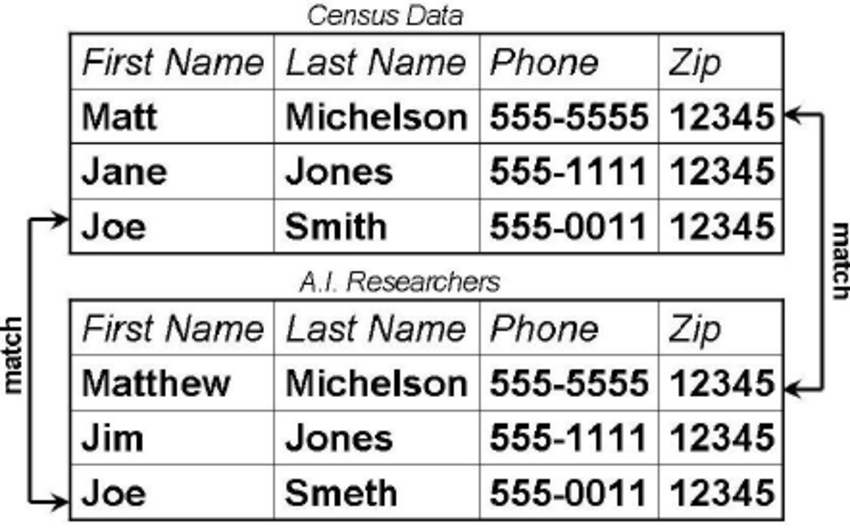
Tekst¶
Als kolommen tekst bevatten dan kan het zijn dat we tekst moeten standardiseren omdat er teveel gelijkende termen gebruikt geweest zijn.
# Standard Library Imports
from pathlib import Path
# Installed packages
import pandas as pd
from pandas_profiling.utils.cache import cache_file
# Read the Titanic Dataset
file_name = cache_file(
"pakistan_intellectual_capital.csv",
"https://raw.githubusercontent.com/bencmbit/datasets/master/pakistan_intellectual_capital.csv",
)
df = pd.read_csv(file_name)
df.head()
| Unnamed: 0 | S# | Teacher Name | University Currently Teaching | Department | Province University Located | Designation | Terminal Degree | Graduated from | Country | Year | Area of Specialization/Research Interests | Other Information | |
|---|---|---|---|---|---|---|---|---|---|---|---|---|---|
| 0 | 2 | 3 | Dr. Abdul Basit | University of Balochistan | Computer Science & IT | Balochistan | Assistant Professor | PhD | Asian Institute of Technology | Thailand | NaN | Software Engineering & DBMS | NaN |
| 1 | 4 | 5 | Dr. Waheed Noor | University of Balochistan | Computer Science & IT | Balochistan | Assistant Professor | PhD | Asian Institute of Technology | Thailand | NaN | DBMS | NaN |
| 2 | 5 | 6 | Dr. Junaid Baber | University of Balochistan | Computer Science & IT | Balochistan | Assistant Professor | PhD | Asian Institute of Technology | Thailand | NaN | Information processing, Multimedia mining | NaN |
| 3 | 6 | 7 | Dr. Maheen Bakhtyar | University of Balochistan | Computer Science & IT | Balochistan | Assistant Professor | PhD | Asian Institute of Technology | Thailand | NaN | NLP, Information Retrieval, Question Answering... | NaN |
| 4 | 24 | 25 | Samina Azim | Sardar Bahadur Khan Women's University | Computer Science | Balochistan | Lecturer | BS | Balochistan University of Information Technolo... | Pakistan | 2005.0 | VLSI Electronics DLD Database | NaN |
countries = df['Country'].unique()
countries.sort()
countries
array([' Germany', ' New Zealand', ' Sweden', ' USA', 'Australia',
'Austria', 'Canada', 'China', 'Finland', 'France', 'Greece',
'HongKong', 'Ireland', 'Italy', 'Japan', 'Macau', 'Malaysia',
'Mauritius', 'Netherland', 'New Zealand', 'Norway', 'Pakistan',
'Portugal', 'Russian Federation', 'Saudi Arabia', 'Scotland',
'Singapore', 'South Korea', 'SouthKorea', 'Spain', 'Sweden',
'Thailand', 'Turkey', 'UK', 'USA', 'USofA', 'Urbana', 'germany'],
dtype=object)
We gaan spaties voor en na verwijderen.
df['Country'] = df['Country'].str.lower()
df['Country'] = df['Country'].str.strip()
We zien dat er landen zijn die gelijkaardig geschreven zijn. We gaan deze fouten proberen te verwijderen.
import fuzzywuzzy
from fuzzywuzzy import process
fuzzywuzzy.process.extract("usa", countries, limit=10, scorer=fuzzywuzzy.fuzz.token_sort_ratio)
/opt/hostedtoolcache/Python/3.7.12/x64/lib/python3.7/site-packages/fuzzywuzzy/fuzz.py:11: UserWarning: Using slow pure-python SequenceMatcher. Install python-Levenshtein to remove this warning
warnings.warn('Using slow pure-python SequenceMatcher. Install python-Levenshtein to remove this warning')
[(' USA', 100),
('USA', 100),
('USofA', 75),
('Austria', 60),
('Australia', 50),
('Spain', 50),
('Urbana', 44),
('UK', 40),
('Malaysia', 36),
('Pakistan', 36)]
We kunnen nu een methode schrijven om de fuzzy matched zaken te gaan matchen en te vervangen.
def replace_matches_in_column(df, column, string_to_match, min_ratio = 47):
# get a list of unique strings
strings = df[column].unique()
# get the top 10 closest matches to our input string
matches = fuzzywuzzy.process.extract(string_to_match, strings,
limit=10, scorer=fuzzywuzzy.fuzz.token_sort_ratio)
# only get matches with a ratio > 90
close_matches = [matches[0] for matches in matches if matches[1] >= min_ratio]
# get the rows of all the close matches in our dataframe
rows_with_matches = df[column].isin(close_matches)
# replace all rows with close matches with the input matches
df.loc[rows_with_matches, column] = string_to_match
# let us know the function's done
print("All done!")
replace_matches_in_column(df=df, column='Country', string_to_match="usa")
All done!
df['Country'].unique()
array(['thailand', 'pakistan', 'germany', 'usa', 'uk', 'china', 'france',
'southkorea', 'malaysia', 'sweden', 'italy', 'canada', 'norway',
'ireland', 'new zealand', 'urbana', 'portugal',
'russian federation', 'finland', 'netherland', 'greece', 'turkey',
'south korea', 'macau', 'singapore', 'japan', 'hongkong',
'saudi arabia', 'mauritius', 'scotland'], dtype=object)
Schalen¶
We gaan gegevens transformeren naar een bepaalde schaal zijnde 0-1 of 0-100. Dit is zeer belangrijk als we ML algorithmes gebruiken die gebruiken maken van afstand tussen 2 punten. Schalen maakt het mogelijk om elke feature een zelfde gewicht te geven bij veranderen. Stel 1 feature is gewicht ik gram en een andere feature is lengte in meter dan gaan we beide features schalen naar iets tussen 0 en 1 zodat we beter kunnen vergelijken.
from mlxtend.preprocessing import minmax_scaling
original_data = np.random.exponential(size = 1000)
# mix-max scale the data between 0 and 1
scaled_data = minmax_scaling(original_data, columns = [0])
# plot both together to compare
fig, ax=plt.subplots(1,2)
sns.histplot(original_data, ax=ax[0])
ax[0].set_title("Original Data")
sns.histplot(scaled_data, ax=ax[1])
ax[1].set_title("Scaled data")
Text(0.5, 1.0, 'Scaled data')
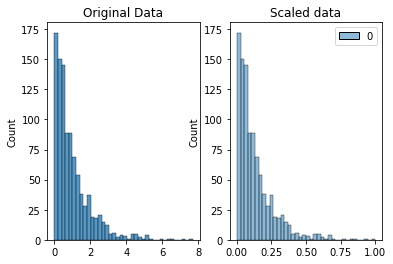
Normaliseren¶
Schalen verandert alleen het bereik van uw gegevens. Normalisatie is een radicalere transformatie. Het punt van normalisatie is om je waarnemingen te veranderen, zodat ze kunnen worden beschreven als een normale verdeling.
Over het algemeen wilt u uw gegevens alleen normaliseren als u een machine learning- of statistiektechniek gaat gebruiken die ervan uitgaat dat uw gegevens normaal verdeeld zijn. Enkele voorbeelden hiervan zijn t-tests, ANOVA’s, lineaire regressie, lineaire discriminantanalyse (LDA) en Gauss-naïeve Bayes.
De methode die werd gebruikt om hier te normaliseren, wordt de Box-Cox-transformatie genoemd. Laten we even kijken hoe het normaliseren van sommige gegevens eruitziet:
from scipy import stats
# normalize the exponential data with boxcox
normalized_data = stats.boxcox(original_data)
# plot both together to compare
fig, ax=plt.subplots(1,2)
sns.histplot(original_data, ax=ax[0])
ax[0].set_title("Original Data")
sns.histplot(normalized_data[0], ax=ax[1])
ax[1].set_title("Normalized data")
Text(0.5, 1.0, 'Normalized data')
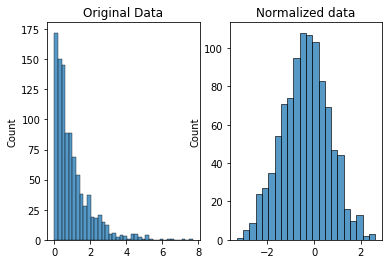
Na de datacleaning stappen kunnen we best nog eens EDA opstarten. EDA in combinatie met Data cleaning is een iteratief process.
Er bestaat ook een low code library die dit alles wat kan vergemakkelijken.
# Standard Library Imports
from pathlib import Path
# Read the Titanic Dataset
file_name = cache_file(
"titanic.csv",
"https://raw.githubusercontent.com/datasciencedojo/datasets/master/titanic.csv",
)
titanic = pd.read_csv(file_name)
titanic.drop(columns="Name",inplace=True)
from pycaret.classification import *
clf1 = setup(titanic, target = 'Survived', silent=True, session_id=123, log_experiment=False, experiment_name='Survived')
| Description | Value | |
|---|---|---|
| 0 | session_id | 123 |
| 1 | Target | Survived |
| 2 | Target Type | Binary |
| 3 | Label Encoded | 0: 0, 1: 1 |
| 4 | Original Data | (891, 11) |
| 5 | Missing Values | True |
| 6 | Numeric Features | 3 |
| 7 | Categorical Features | 7 |
| 8 | Ordinal Features | False |
| 9 | High Cardinality Features | False |
| 10 | High Cardinality Method | None |
| 11 | Transformed Train Set | (623, 568) |
| 12 | Transformed Test Set | (268, 568) |
| 13 | Shuffle Train-Test | True |
| 14 | Stratify Train-Test | False |
| 15 | Fold Generator | StratifiedKFold |
| 16 | Fold Number | 10 |
| 17 | CPU Jobs | -1 |
| 18 | Use GPU | False |
| 19 | Log Experiment | False |
| 20 | Experiment Name | Survived |
| 21 | USI | 8fe0 |
| 22 | Imputation Type | simple |
| 23 | Iterative Imputation Iteration | None |
| 24 | Numeric Imputer | mean |
| 25 | Iterative Imputation Numeric Model | None |
| 26 | Categorical Imputer | constant |
| 27 | Iterative Imputation Categorical Model | None |
| 28 | Unknown Categoricals Handling | least_frequent |
| 29 | Normalize | False |
| 30 | Normalize Method | None |
| 31 | Transformation | False |
| 32 | Transformation Method | None |
| 33 | PCA | False |
| 34 | PCA Method | None |
| 35 | PCA Components | None |
| 36 | Ignore Low Variance | False |
| 37 | Combine Rare Levels | False |
| 38 | Rare Level Threshold | None |
| 39 | Numeric Binning | False |
| 40 | Remove Outliers | False |
| 41 | Outliers Threshold | None |
| 42 | Remove Multicollinearity | False |
| 43 | Multicollinearity Threshold | None |
| 44 | Remove Perfect Collinearity | True |
| 45 | Clustering | False |
| 46 | Clustering Iteration | None |
| 47 | Polynomial Features | False |
| 48 | Polynomial Degree | None |
| 49 | Trignometry Features | False |
| 50 | Polynomial Threshold | None |
| 51 | Group Features | False |
| 52 | Feature Selection | False |
| 53 | Feature Selection Method | classic |
| 54 | Features Selection Threshold | None |
| 55 | Feature Interaction | False |
| 56 | Feature Ratio | False |
| 57 | Interaction Threshold | None |
| 58 | Fix Imbalance | False |
| 59 | Fix Imbalance Method | SMOTE |
X = get_config('X')
X.shape
(891, 568)
clf1 = setup(titanic, target = 'Survived', normalize = True ,silent=True, session_id=123, log_experiment=False, experiment_name='Survived')
| Description | Value | |
|---|---|---|
| 0 | session_id | 123 |
| 1 | Target | Survived |
| 2 | Target Type | Binary |
| 3 | Label Encoded | 0: 0, 1: 1 |
| 4 | Original Data | (891, 11) |
| 5 | Missing Values | True |
| 6 | Numeric Features | 3 |
| 7 | Categorical Features | 7 |
| 8 | Ordinal Features | False |
| 9 | High Cardinality Features | False |
| 10 | High Cardinality Method | None |
| 11 | Transformed Train Set | (623, 567) |
| 12 | Transformed Test Set | (268, 567) |
| 13 | Shuffle Train-Test | True |
| 14 | Stratify Train-Test | False |
| 15 | Fold Generator | StratifiedKFold |
| 16 | Fold Number | 10 |
| 17 | CPU Jobs | -1 |
| 18 | Use GPU | False |
| 19 | Log Experiment | False |
| 20 | Experiment Name | Survived |
| 21 | USI | 6472 |
| 22 | Imputation Type | simple |
| 23 | Iterative Imputation Iteration | None |
| 24 | Numeric Imputer | mean |
| 25 | Iterative Imputation Numeric Model | None |
| 26 | Categorical Imputer | constant |
| 27 | Iterative Imputation Categorical Model | None |
| 28 | Unknown Categoricals Handling | least_frequent |
| 29 | Normalize | True |
| 30 | Normalize Method | zscore |
| 31 | Transformation | False |
| 32 | Transformation Method | None |
| 33 | PCA | False |
| 34 | PCA Method | None |
| 35 | PCA Components | None |
| 36 | Ignore Low Variance | False |
| 37 | Combine Rare Levels | False |
| 38 | Rare Level Threshold | None |
| 39 | Numeric Binning | False |
| 40 | Remove Outliers | False |
| 41 | Outliers Threshold | None |
| 42 | Remove Multicollinearity | False |
| 43 | Multicollinearity Threshold | None |
| 44 | Remove Perfect Collinearity | True |
| 45 | Clustering | False |
| 46 | Clustering Iteration | None |
| 47 | Polynomial Features | False |
| 48 | Polynomial Degree | None |
| 49 | Trignometry Features | False |
| 50 | Polynomial Threshold | None |
| 51 | Group Features | False |
| 52 | Feature Selection | False |
| 53 | Feature Selection Method | classic |
| 54 | Features Selection Threshold | None |
| 55 | Feature Interaction | False |
| 56 | Feature Ratio | False |
| 57 | Interaction Threshold | None |
| 58 | Fix Imbalance | False |
| 59 | Fix Imbalance Method | SMOTE |
X = get_config('X')
X.head().apply(lambda s: s.apply(lambda x: format(x, 'f')))
| Age | Fare | Pclass_1 | Pclass_2 | Pclass_3 | Sex_female | SibSp_0 | SibSp_1 | SibSp_2 | SibSp_3 | ... | Cabin_E8 | Cabin_F E69 | Cabin_F2 | Cabin_F33 | Cabin_F4 | Cabin_G6 | Cabin_not_available | Embarked_C | Embarked_Q | Embarked_S | |
|---|---|---|---|---|---|---|---|---|---|---|---|---|---|---|---|---|---|---|---|---|---|
| 0 | -0.620440 | -0.480292 | 0.000000 | 0.000000 | 1.000000 | 0.000000 | 0.000000 | 1.000000 | 0.000000 | 0.000000 | ... | 0.000000 | 0.000000 | 0.000000 | 0.000000 | 0.000000 | 0.000000 | 1.000000 | 0.000000 | 0.000000 | 1.000000 |
| 1 | 0.638427 | 0.699093 | 1.000000 | 0.000000 | 0.000000 | 1.000000 | 0.000000 | 1.000000 | 0.000000 | 0.000000 | ... | 0.000000 | 0.000000 | 0.000000 | 0.000000 | 0.000000 | 0.000000 | 0.000000 | 1.000000 | 0.000000 | 0.000000 |
| 2 | -0.305723 | -0.467859 | 0.000000 | 0.000000 | 1.000000 | 1.000000 | 1.000000 | 0.000000 | 0.000000 | 0.000000 | ... | 0.000000 | 0.000000 | 0.000000 | 0.000000 | 0.000000 | 0.000000 | 1.000000 | 0.000000 | 0.000000 | 1.000000 |
| 3 | 0.402390 | 0.364187 | 1.000000 | 0.000000 | 0.000000 | 1.000000 | 0.000000 | 1.000000 | 0.000000 | 0.000000 | ... | 0.000000 | 0.000000 | 0.000000 | 0.000000 | 0.000000 | 0.000000 | 0.000000 | 0.000000 | 0.000000 | 1.000000 |
| 4 | 0.402390 | -0.465557 | 0.000000 | 0.000000 | 1.000000 | 0.000000 | 1.000000 | 0.000000 | 0.000000 | 0.000000 | ... | 0.000000 | 0.000000 | 0.000000 | 0.000000 | 0.000000 | 0.000000 | 1.000000 | 0.000000 | 0.000000 | 1.000000 |
5 rows × 567 columns
X.Fare.plot.hist()
<AxesSubplot:ylabel='Frequency'>
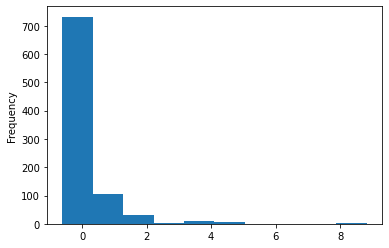
clf1 = setup(titanic, target = 'Survived', transformation = True ,silent=True, session_id=123, log_experiment=False, experiment_name='Survived')
| Description | Value | |
|---|---|---|
| 0 | session_id | 123 |
| 1 | Target | Survived |
| 2 | Target Type | Binary |
| 3 | Label Encoded | 0: 0, 1: 1 |
| 4 | Original Data | (891, 11) |
| 5 | Missing Values | True |
| 6 | Numeric Features | 3 |
| 7 | Categorical Features | 7 |
| 8 | Ordinal Features | False |
| 9 | High Cardinality Features | False |
| 10 | High Cardinality Method | None |
| 11 | Transformed Train Set | (623, 567) |
| 12 | Transformed Test Set | (268, 567) |
| 13 | Shuffle Train-Test | True |
| 14 | Stratify Train-Test | False |
| 15 | Fold Generator | StratifiedKFold |
| 16 | Fold Number | 10 |
| 17 | CPU Jobs | -1 |
| 18 | Use GPU | False |
| 19 | Log Experiment | False |
| 20 | Experiment Name | Survived |
| 21 | USI | 2bbe |
| 22 | Imputation Type | simple |
| 23 | Iterative Imputation Iteration | None |
| 24 | Numeric Imputer | mean |
| 25 | Iterative Imputation Numeric Model | None |
| 26 | Categorical Imputer | constant |
| 27 | Iterative Imputation Categorical Model | None |
| 28 | Unknown Categoricals Handling | least_frequent |
| 29 | Normalize | False |
| 30 | Normalize Method | None |
| 31 | Transformation | True |
| 32 | Transformation Method | yeo-johnson |
| 33 | PCA | False |
| 34 | PCA Method | None |
| 35 | PCA Components | None |
| 36 | Ignore Low Variance | False |
| 37 | Combine Rare Levels | False |
| 38 | Rare Level Threshold | None |
| 39 | Numeric Binning | False |
| 40 | Remove Outliers | False |
| 41 | Outliers Threshold | None |
| 42 | Remove Multicollinearity | False |
| 43 | Multicollinearity Threshold | None |
| 44 | Remove Perfect Collinearity | True |
| 45 | Clustering | False |
| 46 | Clustering Iteration | None |
| 47 | Polynomial Features | False |
| 48 | Polynomial Degree | None |
| 49 | Trignometry Features | False |
| 50 | Polynomial Threshold | None |
| 51 | Group Features | False |
| 52 | Feature Selection | False |
| 53 | Feature Selection Method | classic |
| 54 | Features Selection Threshold | None |
| 55 | Feature Interaction | False |
| 56 | Feature Ratio | False |
| 57 | Interaction Threshold | None |
| 58 | Fix Imbalance | False |
| 59 | Fix Imbalance Method | SMOTE |
X = get_config('X')
X.head().apply(lambda s: s.apply(lambda x: format(x, 'f')))
| Age | Fare | Pclass_1 | Pclass_2 | Pclass_3 | Sex_female | SibSp_0 | SibSp_1 | SibSp_2 | SibSp_3 | ... | Cabin_E77 | Cabin_E8 | Cabin_F E69 | Cabin_F33 | Cabin_G6 | Cabin_T | Cabin_not_available | Embarked_C | Embarked_Q | Embarked_S | |
|---|---|---|---|---|---|---|---|---|---|---|---|---|---|---|---|---|---|---|---|---|---|
| 0 | -0.585410 | -0.839834 | 0.000000 | 0.000000 | 1.000000 | 0.000000 | 0.000000 | 1.000000 | 0.000000 | 0.000000 | ... | 0.000000 | 0.000000 | 0.000000 | 0.000000 | 0.000000 | 0.000000 | 1.000000 | 0.000000 | 0.000000 | 1.000000 |
| 1 | 0.658780 | 1.306386 | 1.000000 | 0.000000 | 0.000000 | 1.000000 | 0.000000 | 1.000000 | 0.000000 | 0.000000 | ... | 0.000000 | 0.000000 | 0.000000 | 0.000000 | 0.000000 | 0.000000 | 0.000000 | 1.000000 | 0.000000 | 0.000000 |
| 2 | -0.261811 | -0.753659 | 0.000000 | 0.000000 | 1.000000 | 1.000000 | 1.000000 | 0.000000 | 0.000000 | 0.000000 | ... | 0.000000 | 0.000000 | 0.000000 | 0.000000 | 0.000000 | 0.000000 | 1.000000 | 0.000000 | 0.000000 | 1.000000 |
| 3 | 0.434577 | 1.046076 | 1.000000 | 0.000000 | 0.000000 | 1.000000 | 0.000000 | 1.000000 | 0.000000 | 0.000000 | ... | 0.000000 | 0.000000 | 0.000000 | 0.000000 | 0.000000 | 0.000000 | 0.000000 | 0.000000 | 0.000000 | 1.000000 |
| 4 | 0.434577 | -0.738490 | 0.000000 | 0.000000 | 1.000000 | 0.000000 | 1.000000 | 0.000000 | 0.000000 | 0.000000 | ... | 0.000000 | 0.000000 | 0.000000 | 0.000000 | 0.000000 | 0.000000 | 1.000000 | 0.000000 | 0.000000 | 1.000000 |
5 rows × 567 columns
X.Fare.plot.hist()
<AxesSubplot:ylabel='Frequency'>
